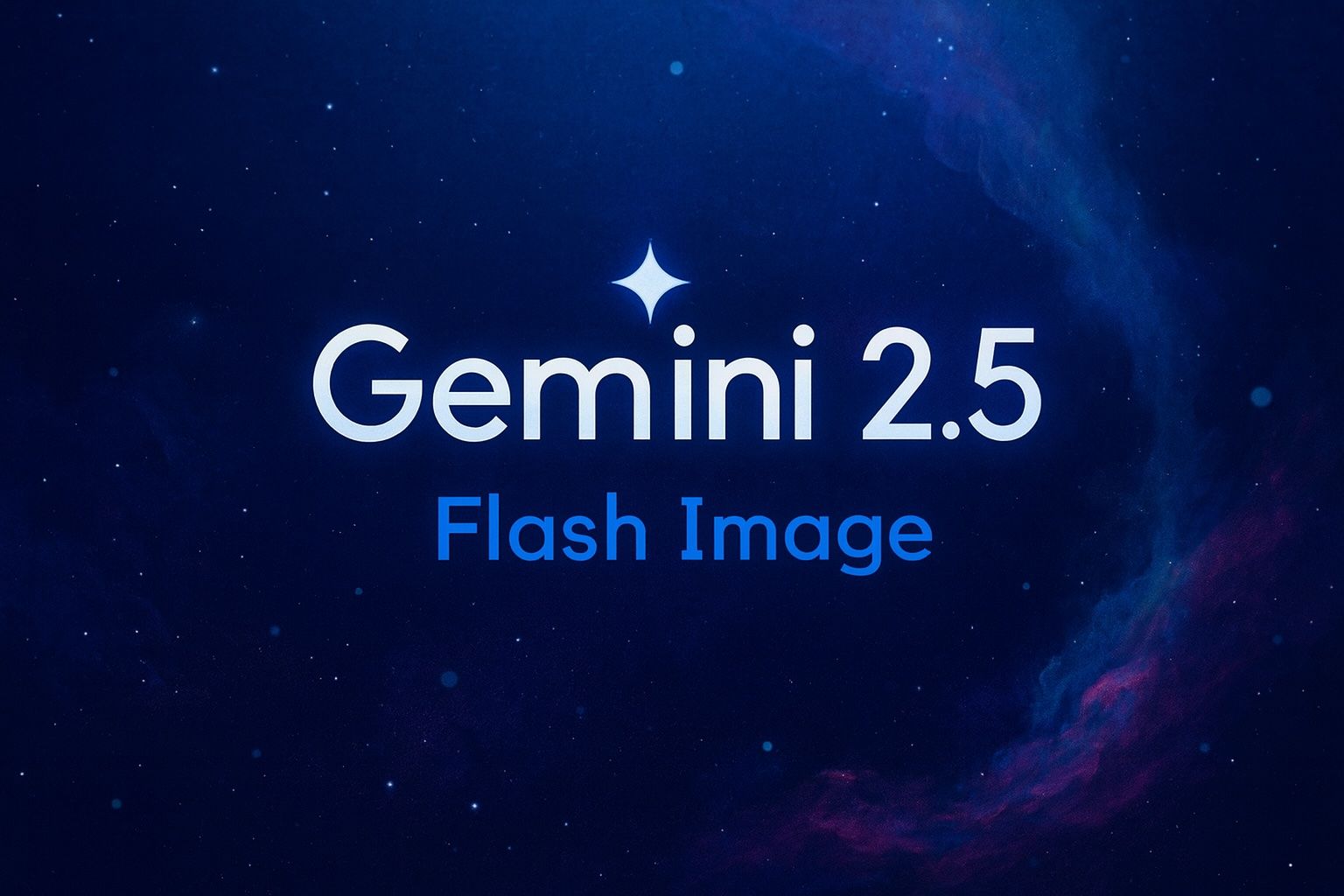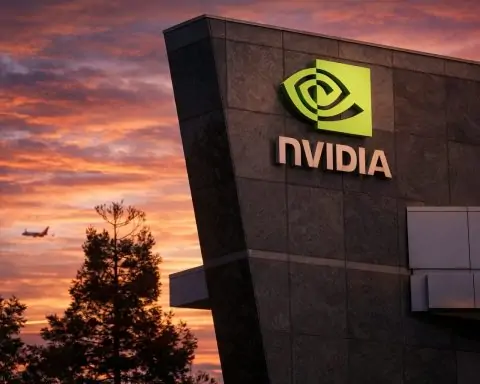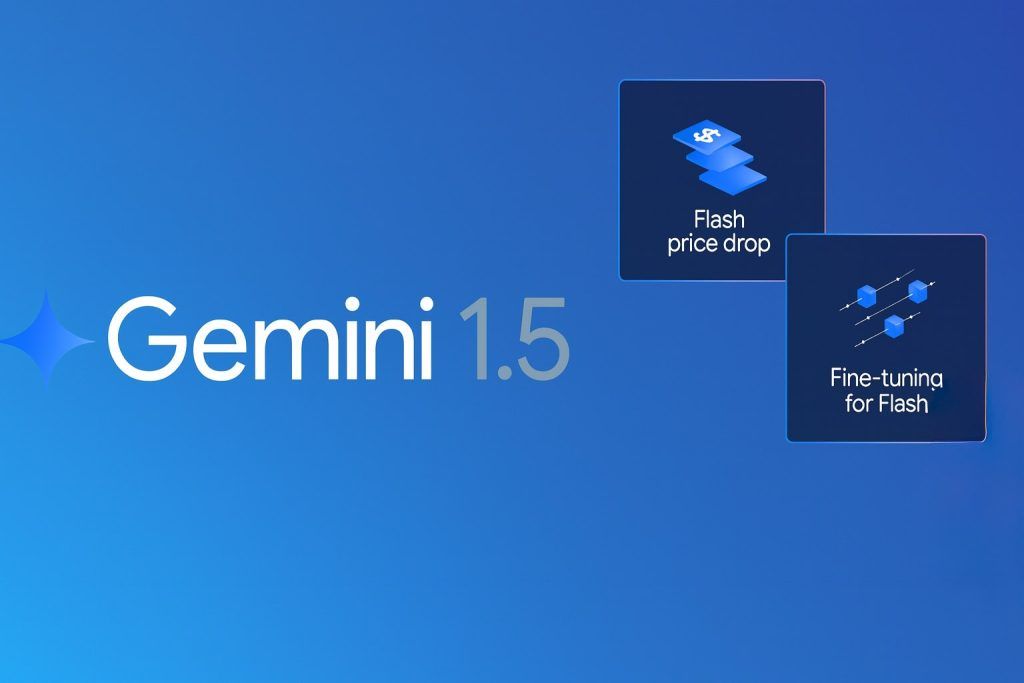- State-of-the-Art Image AI – Gemini 2.5 Flash Image is Google’s latest generative AI model for images, delivering best-in-class image creation and editing with simple prompts [1]. It can blend multiple images into one, ensure consistent characters across images, and follow natural-language editing requests with precision [2].
- Blazing Fast & Cost-Effective – Built on Google’s “Flash” architecture for low latency, it generates images in seconds. Each image output is about 1,290 tokens (≈$0.039 per image) under the pay-as-you-go pricing [3] – reflecting Gemini Flash’s focus on speed and efficiency.
- “Thinking” Enabled – Unlike static models, Gemini 2.5 models perform an internal reasoning process (“think”) before responding [4]. Developers can adjust a
thinkingBudgetparameter to control how long the AI deliberates, trading speed for deeper reasoning on complex tasks [5]. - Multiple Model Variants – The Gemini 2.5 family includes Flash-Lite, Flash, and Pro versions. Flash-Lite is the fastest and most cost-efficient (ideal for high-volume tasks), Flash is a balanced general model, and Pro is the most powerful for complex “agentic” tasks like coding [6]. All variants support tool use (web search, code execution) and multimodal inputs with an unprecedented 1 million-token context window [7].
- Developer-Friendly Tools – Google launched Gemini CLI, a free open-source AI agent that brings Gemini’s powers to the command line. It offers 60 requests/minute and 1,000 requests/day for free (using Gemini 2.5 Pro) [8], letting developers code, troubleshoot, and even execute shell commands via AI. The related Gemini Code Assist integrates into VS Code, using an agent that plans multi-step fixes and writes code alongside you [9]. There’s also Gemini Live Voice Mode in the Gemini app, which enables real-time voice conversations with the AI, turning spoken ideas into an interactive brainstorm [10].
- Topping Benchmarks – Early evaluations show Gemini 2.5 Flash Image achieving #1 rankings on text-to-image and image editing benchmarks as of late August 2025 [11]. Google touts its “visual quality” and instruction-following as pushing the state of the art [12] – giving it an edge in preserving fine details that often trip up rivals like DALL·E or xAI’s Grok [13].
- Broad Availability – Gemini 2.5 Flash Image is available now via the Gemini API and Google AI Studio for developers, and through Vertex AI for enterprise customers [14]. It’s also live in Google’s consumer Gemini app (with ~450 million users per month) and integrated into products like Google Search and Workspace. Business users can access it through Gemini for Workspace in Google’s productivity apps, while third parties like Adobe Firefly are integrating it to enhance creative workflows [15].
Gemini 2.5 Flash Image Is Here: How Google’s Newest AI Beats MidJourney, GPT-5, and Claude in Creativity and Speed
Google’s Gemini 2.5 Flash Image is making waves as a breakthrough in generative AI – combining blazing speed, advanced reasoning, and multimodal versatility. Announced in late August 2025 on Google’s AI blog, this model is the latest addition to the Gemini 2.5 family, and it has been codenamed “nano-banana” during testing [16]. Flash Image extends Google’s flagship Gemini AI into image generation and editing, letting users create vivid pictures or modify existing images just by describing what they want. The new model arrives with bold claims: Google says it’s now state-of-the-art in both image creation and editing tasks [17], and early benchmark results appear to back that up. So what exactly is Gemini 2.5 Flash Image, and how does it stack up against competitors like MidJourney and OpenAI? Let’s dive in.
Gemini 2.5 Flash Image: Advanced Image Generation & Editing
Gemini 2.5 Flash Image represents a significant leap forward in AI’s ability to generate and manipulate images with fine-grained control. It’s not just another text-to-image model – it’s designed as a native image capability within Google’s broader Gemini AI system [18], meaning it benefits from the same rich training and world knowledge as Google’s language models. Here are some of the standout capabilities that make Flash Image a powerful creative tool:
- Natural Language Photo Editing: You can ask Gemini to modify an image with simple sentences, and it will perform targeted transformations and local edits with surprising accuracy [19] [20]. For example, you might say “blur the background” of a photo or “change the shirt color to red,” and Gemini will do it while preserving details like faces and backgrounds that shouldn’t be altered [21]. Google emphasizes that Flash Image can make precise edits without warping a person’s face or the overall scene – a common failure of earlier tools. In fact, users in early tests raved about an anonymous “nano-banana” image editor (which was Gemini in disguise) for its ability to handle such edits gracefully [22].
- Character & Style Consistency: A long-standing challenge in image generation has been keeping a character or object’s appearance consistent across multiple images. Flash Image tackles this by letting you carry over the same character or art style through different prompts and edits [23]. You could generate a storybook with the same protagonist appearing on every page in different scenes, or place a product in various settings while retaining its exact look. This consistency – essentially a form of visual memory – saves time otherwise spent on fine-tuning. Google has already seen developers use this to create things like branded image sets and multi-scene storyboards with a cohesive look [24].
- Multi-Image Fusion: Gemini 2.5 Flash Image can take multiple input images and intelligently merge them into one composite output [25]. In practice, this might mean taking a photo of a person and a separate image of a pet, and blending them so it looks like the person is holding the pet in the same scene. An example shown by Google fused a picture of an athlete with a dog, resulting in a realistic image of the athlete cuddling that dog [26]. Users can also use this feature for creative mashups – e.g. dragging product images into a scene or mood board and letting the model generate a seamless combined image. The ability to handle omni-reference inputs (what MidJourney calls “Omni Reference” in its latest version [27]) means Flash Image is adept at contextualizing multiple visual inputs in one go.
- Built-In World Knowledge: Because Flash Image is part of the Gemini family (not an isolated image model), it has been trained with a deep understanding of real-world concepts and facts. This “native world knowledge” lets it comprehend and generate images with semantic accuracy [28]. For instance, it can read a hand-drawn diagram or text in an image and respond meaningfully, or produce images that align with real historical or scientific details. Google demonstrated this by turning a simple drawing on a canvas into an interactive educational tutor – the model could recognize the drawn content and generate a helpful visual explanation [29]. In other words, Flash Image isn’t just about making pretty pictures; it can reason about image content, making it suitable for educational, medical, or analytical visual applications that require factual correctness.
These capabilities make Gemini 2.5 Flash Image a versatile tool for both creative design and practical editing tasks. Whether you’re a marketer assembling product photos, a teacher creating visual aids, or just a user fixing up personal photos, Flash Image aims to handle it through simple dialogue. All images created or modified by the model are also cryptographically watermarked with Google’s SynthID technology [30]. This invisible watermark ensures AI-generated images can later be identified as such, supporting responsible use of generative media.
Speed and “Flash” Performance
One of the hallmarks of the Gemini “Flash” series is speed. True to its name, Gemini 2.5 Flash Image is optimized for low latency and high throughput – without sacrificing quality. When Google first introduced the Flash image generation in Gemini 2.0 earlier this year, users loved its snappy responses and cost-effectiveness, but wanted even higher fidelity results [31]. The 2.5 Flash Image update delivers that fidelity boost while keeping inference times short.
Under the hood, Flash Image benefits from the same efficiency focus that the text-based Gemini Flash models have. Google describes the 2.5 family as “hybrid reasoning models” that sit on the Pareto frontier of cost and speed [32] – meaning they’ve tried to maximize intelligence per compute dollar. In practical terms, Flash Image can generate or edit an image in a matter of seconds in many cases, enabling near-real-time interactions. For example, Quora’s Poe team noted that Gemini 2.5 Flash Image had “low response times” that enable “natural, conversational editing loops” – even allowing real-time image apps on their platform [33].
The pricing model reflects this efficiency. As of launch, Gemini 2.5 Flash Image is priced at $30 per 1 million output tokens, with each image counted as 1290 tokens [34]. This works out to roughly $0.039 per image generated. (For comparison, generating images via other AI APIs often costs on the order of $0.02–$0.10 per image, so Gemini’s pricing is in a similar ballpark, especially given its advanced capabilities.) Notably, any text tokens in the prompt or response are charged at the normal Gemini 2.5 Flash rates [35], but those tend to be negligible compared to the image cost. The take-away: you can integrate Flash Image into apps or workflows without breaking the bank, and get results fast enough for interactive use.
How is it so fast? Google hasn’t published full architectural details, but the “Flash” moniker suggests heavy model optimization and perhaps using a smaller-but-efficient model architecture compared to the giant “Pro” models. It likely uses a combination of advanced serving infrastructure (TPUs/GPUs optimized for multimodal tasks) and architecture tuning. Also, Gemini 2.5 Flash Image is a unified multimodal model – not a two-step process where one model generates an image from a text description produced by another. This tight integration (akin to OpenAI’s GPT-4 Vision approach) can eliminate overhead and improve latency. In short, Flash Image is purpose-built for speedy inference in production settings, which is crucial for user-facing products (nobody wants to wait around for an image to render).
Google is already leveraging that speed across its products. The Gemini app, for example, allows users to upload a photo and converse with Gemini to edit it, with near-instant results. And on the enterprise side, Adobe has integrated Gemini 2.5 Flash Image into Adobe Firefly and Express – providing creators a fast, on-demand image generation option right inside Adobe’s tools [36]. We’re likely to see more such integrations since a speedy, cheap image model is very attractive for apps that need dynamic visuals.
“Thinking” Models: Gemini 2.5 Flash, Flash-Lite, and Pro
Beyond images, Gemini 2.5 represents a broader family of AI models that power Google’s generative AI offerings. Google has billed these as “thinking models”, highlighting a key feature: they can reason through intermediate steps internally before giving a final answer [37]. This is similar in spirit to techniques like “chain-of-thought” prompting, but it’s built into the model’s usage. Each Gemini 2.5 model has a configurable thinking budget – essentially, how much extra computation or internal dialogue it’s allowed to do to improve an answer. If a question is straightforward, you might set a low (or zero) thinking budget for speed. But for a complex problem (coding, math, etc.), increasing the thinking budget lets the model work out the solution step by step for higher accuracy [38].
Google exposed this control to developers via an API parameter. For example, Gemini 2.5 Pro might by default take a few extra beats to “think,” whereas Flash-Lite (designed for speed) runs with thinking turned off unless you explicitly allow it [39]. In fact, Gemini 2.5 Flash-Lite is optimized so heavily for speed and cost that it disables the thinking process by default entirely [40] – making it behave more like a traditional prompt-in, answer-out model unless you opt in to reasoning for specific queries. By contrast, Gemini 2.5 Pro always engages its full reasoning capabilities (its thinking cannot be turned off at all) and is meant for the most challenging tasks [41].
So what are these model variants exactly?
- Gemini 2.5 Pro: This is the heavyweight model aimed at maximal capability. It has the highest intelligence, largest size, and best performance on complex tasks (e.g. difficult coding challenges, multi-hop reasoning, intricate creative writing). Pro uses the full “thinking” all the time and also supports the complete range of tools and functions. As Google puts it, Pro “shines” when you need the “highest intelligence and most capabilities”, like agentic planning or heavy coding assistance [42]. Many advanced developer tools (Cursor, Replit’s Ghostwriter, etc.) embedded early versions of Gemini Pro to leverage its reasoning power [43]. The trade-off is that Pro is the most resource-intensive – it’s slower and costlier per token than the Flash models. It’s now generally available (stable) as of mid-2025.
- Gemini 2.5 Flash: The Flash model is the all-purpose workhorse – offering an excellent balance of performance vs. speed. It was first previewed around May 2025 (notably, an earlier version of Flash was demoed at Google I/O 2025) and is now stable. Flash is significantly faster and cheaper than Pro while still delivering strong quality for most tasks. It can handle creative writing, Q&A, summarization, light coding help, etc., with low latency. Importantly, Flash can perform the “thinking” process for harder questions, but you have the option to disable that if you need pure speed [44]. Google adjusted the pricing of Flash on general release – it now has a single unified price (no surcharge for using thinking mode) [45] [46]. This simplified pricing underscores that Flash is meant to be versatile – you don’t have to worry about toggling modes from a billing perspective; just use thinking when needed.
- Gemini 2.5 Flash-Lite: Introduced in preview on June 17, 2025 [47] [48], Flash-Lite is the newest and leanest model in the family. It’s designed for ultra-fast, high-volume scenarios and is Google’s most cost-efficient 2.5 model. Essentially, Flash-Lite is what you’d use for tasks like real-time translation, classification, or formulating short responses at scale [49]. It has lower latency than even 2.0 Flash and the current 2.5 Flash, according to Google’s internal benchmarks [50]. Despite being “lite,” it actually shows higher quality than the older 2.0 models on many coding, math, reasoning, and multimodal tests [51] – a testament to improvements in the underlying architecture. Flash-Lite supports all of Gemini’s native tools (more on those soon) including web grounding, code execution, and even URL-based context injection, plus function calling [52]. But, as mentioned, to achieve maximum speed, it defaults to zero thinking. Developers can dynamically “turn thinking on at different budgets” if a particular query needs it [53]. In short, Flash-Lite gives you the option to run very fast with minimal reasoning or dial up the reasoning when accuracy is more important than speed.
All three variants share some powerful features that define the Gemini 2.5 generation:
- Tool Use and Agentic Behavior: Gemini 2.5 models can integrate with external tools seamlessly. They can perform web searches to fetch real-time information (a feature Google calls “Grounding with Google Search”), execute code snippets, and call functions/APIs that you define [54]. This effectively gives them eyes and hands – they aren’t limited to their trained knowledge cutoff. For example, if asked a question about today’s stock prices, Gemini can invoke a live web search to get up-to-date data. Or if given a coding task, it can run a Python function to test outputs. This tool-use ability, combined with the thinking mode, enables complex “agent” behaviors where the model can plan steps, try solutions, and correct itself before finalizing an answer [55]. Notably, OpenAI and Anthropic have similar features (OpenAI’s plugins and Code Interpreter; Anthropic’s “computer use” in Claude [56] [57]). Google’s approach integrates these into the core API in a developer-friendly way.
- Multimodal Inputs & Outputs: All Gemini 2.5 models are inherently multimodal. This means they can accept not just text, but also images (and possibly other formats) as inputs. We see this with Flash Image – the API allows sending both a text prompt and an image (or multiple images) into the model and it will comprehend both [58]. Likewise, the text models can analyze images (e.g. you could show Gemini a chart or a photo and ask questions about it). On output, besides text, Gemini can return images (as with Flash Image) or even other media types. For instance, the Gemini app can produce spoken audio – it has a text-to-speech so the AI can talk back in voice mode. And one of Google’s demos showed the model generating an SVG chart that it could render in a “preview” window [59], thanks to a feature in Code Assist. This flexibility in modes aligns with a broader industry trend: AI models are becoming all-in-one multimodal assistants. Gemini 2.5 is a prime example of that.
- Massive Context Window: Perhaps one of the flashiest specs – Gemini 2.5 models support a context window of up to 1 million tokens [60]. This is an astronomical length (equivalent to about 800,000 words, or roughly 3,000 pages of text!). In practical terms, you could feed the model almost an entire library of documents or a huge codebase, and it can consider all that information when responding. This capability is still in early stages (there are likely constraints on how to effectively use so many tokens), but even at six figures it’s hugely beneficial. For example, you could ask Gemini to analyze a very large dataset or lengthy legal brief without chunking it into pieces. By comparison, OpenAI’s GPT-4 maxes out around 128,000 tokens in specialized versions, and Anthropic’s Claude had reached 100k–200k in 2024 and was working toward the million-token range as well [61] [62]. Google hitting 1M tokens is a flex of their engineering – it suggests they have optimized memory management and model attention in novel ways. One caveat: extremely long contexts can slow down responses and are costly. But for those who need it (e.g. analyzing whole code repositories or doing book-scale QA), Gemini can handle it in one go. As a user, it simply means Gemini can “remember” and reference vastly more context from the conversation or documents you provide.
In summary, the Gemini 2.5 model family (Flash-Lite, Flash, Pro) offers a scalable approach to AI: you pick the model that fits your use case, from ultra-fast interactions to deep problem-solving, and you still get access to cutting-edge features like tool integration, multimodal understanding, and huge context memory across the board.
New Tools for Developers and Users
Alongside the model upgrades, Google has rolled out new tools and interfaces to help both developers and end-users get the most out of Gemini 2.5. These tools lower the barrier to entry for using the models and showcase some of Gemini’s capabilities in real-world workflows. Here are a few notable ones:
Gemini CLI: Your AI Assistant in the Terminal
For developers who live in the command line, Gemini CLI is a game-changer. Announced in June 2025, Gemini CLI is an open-source AI agent that brings the power of Gemini directly to your terminal [63]. You can think of it as a ChatGPT-like assistant, but running locally in your shell and deeply integrated with your development workflow. It excels at coding tasks – like explaining code, generating functions, or debugging errors – all through natural language prompts. But it’s not limited to code; you can ask Gemini CLI to draft content, manage tasks, or even control your system.
A few standout features of Gemini CLI:
- Free Access to Gemini 2.5 Pro: Individual developers can use Gemini CLI completely free by logging in with a Google account. Google is providing a complimentary Gemini Code Assist license for personal use, which unlocks the full Gemini 2.5 Pro model behind the scenes [64] [65]. This is a big deal – it means solo developers get to play with one of Google’s most advanced models at no cost, with very generous limits.
- Unmatched Usage Limits: During the preview, Google offers 60 requests per minute and up to 1,000 requests per day for free through Gemini CLI [66] [67]. This allowance is far more than typical free tiers (for instance, ChatGPT’s free tier or other coding assistants). It ensures that most users “rarely, if ever, hit a limit” in normal use [68]. Essentially, Google wants developers to adopt Gemini CLI as a daily tool without worrying about paywalls.
- Terminal Superpowers: Gemini CLI can do a lot right from your shell. It has built-in tools to search the web (so you can pull in documentation or get real-time info) [69], manipulate files (read from or write to your local files if you allow), and even execute shell commands on your behalf [70]. This means you could tell it, “find all TODO comments in my project and open those files,” and it could actually run the grep and open commands to do that. It essentially can function as a junior developer sitting in your terminal, automating tasks.
- MCP and Extensibility: Gemini CLI supports the Model Context Protocol (MCP) for extensions [71]. This is an emerging standard (also embraced by Anthropic and others) for allowing AI agents to use external tools and maintain context across actions. Through MCP, you can add plugins or connect Gemini CLI to other services fairly easily. The CLI also supports system prompt customizations and team settings, so it’s quite configurable for power users [72].
Importantly, Gemini CLI shares its tech with Google’s coding assistant for IDEs, Gemini Code Assist [73] [74]. This means the improvements and capabilities of one are reflected in the other. If you prefer working in VS Code with a GUI, Code Assist will give you chat and inline completions; if you prefer the terminal, Gemini CLI has you covered – and both are using the same underlying Gemini brain.
Gemini Code Assist: AI Pair Programmer in VS Code
Gemini Code Assist is Google’s answer to GitHub Copilot and Replit Ghostwriter, integrated into Visual Studio Code. It originally launched in late 2023 (Gemini 1.5 era) and by 2025 it has evolved into a very sophisticated coding aide. With the advent of Gemini 2.5, Code Assist gained an “agent mode” that essentially turns it into an AI pair programmer that can take on tasks autonomously [75].
In agent mode, you can ask Code Assist to do something like: “Refactor this function for better clarity and add unit tests.” The AI will come up with a multi-step plan, start editing your code, run tests (via the code execution tool), fix any errors it encounters, and iterate until it’s done [76]. This is far beyond simple code completion. Google describes this as a “multi-step, collaborative, reasoning agent” for coding [77]. Under the hood, it’s using Gemini 2.5 Pro with thinking enabled to break problems into steps and possibly use the MCP system to carry out actions (like running code or using a linter).
Gemini Code Assist’s agent can even do things like migrate your codebase from one framework to another, or find bugs by logically testing different inputs. It’s like having a tireless junior developer who can execute instructions quickly. And thanks to integration with Gemini CLI, you can also invoke these capabilities in the terminal or even in CI pipelines (Google introduced Gemini CLI GitHub Actions to automate code reviews and issue triage in repos [78]).
For developers and companies, Code Assist is offered in free, Standard, and Enterprise tiers, but as mentioned, even the free tier now has the highest usage limits in the market (mirroring the CLI’s 1k/day allowance) [79]. This generosity in usage hints at Google’s strategy: they want to entice developers away from rival coding AIs (like Copilot) by offering more for less. With Code Assist powered by Gemini 2.5, Google can claim competitive strengths such as using the 1M-token context to load entire projects, or better handling of multi-modal inputs (e.g., you could paste a screenshot of an error and Gemini might parse it).
Gemini Live Voice Mode: Real-Time Conversations with AI
On the consumer side, Google has been enhancing the Gemini app – which is like its equivalent of the ChatGPT app – with more interactive features. One of the most exciting is Live Voice Mode, which allows users to talk to Gemini and hear it respond in a human-like voice, all in real time [80]. This effectively transforms Gemini into a conversational AI assistant that you can brainstorm with, ask questions, or even practice languages with, without typing.
Live Voice Mode started rolling out to Android users in late 2024, initially as part of a premium offering, but Google has since made it free for everyone by September 2024 [81] [82]. Using it is as simple as tapping a button in the Gemini mobile app to “Go Live” – then you just speak your query or prompt. Gemini will process your voice input (using Google’s speech recognition), generate a response, and then speak back the answer using text-to-speech. The conversation flows naturally, and you can interrupt or ask follow-ups just as you would in a phone call.
The goal of Live Voice is to make interactions with AI feel as natural as talking to a friend. Instead of the old voice assistants that were command-driven (“What’s the weather?”), Gemini Live can handle open-ended, dynamic conversations. You might discuss a complex project idea out loud and let the AI help you think it through, or use it as a hands-free brainstorming partner while you’re on a walk. The AI’s responses aim to be context-aware and lengthy, not the one-shot answers of Siri or Google Assistant of old.
Under the hood, Live Voice Mode likely leverages the thinking capability of Gemini (to maintain coherent multi-turn dialogue) and the multimodal features (to convert speech to text and vice versa). It’s also a showcase for Google’s latest voice synthesis tech – presumably using something like their 2023 AudioPaLM or Bark models to produce natural speech. By mid-2025, Google expanded Gemini Live to dozens of languages [83], enabling bilingual or multilingual conversations (great for practice or translation scenarios).
This voice feature puts Google in direct competition with OpenAI’s recently announced voice for ChatGPT and other AI companions. It’s a key part of making AI assistants more accessible – not everyone can or wants to type long prompts, but most people can talk. Given Google’s Android ecosystem, millions of users now have free access to voice chats with Gemini [84], which might accelerate adoption of AI for everyday tasks. It’s also easy to imagine this Live Voice tech coming to Google’s hardware (Pixel phones, maybe a future Pixel assistant device) and even the car or smart home via Assistant integration.
Gemini 2.5 Flash Image vs. MidJourney V7 and DALL·E 3
How does Google’s new image model stand up against the incumbents of AI image generation? MidJourney and OpenAI’s DALL·E (now effectively part of GPT-4’s toolbox) are the two big names in this space. Each has its strengths, and now Gemini 2.5 Flash Image is entering the fray claiming state-of-the-art status. Let’s compare their capabilities as of 2025:
MidJourney V7: MidJourney has long been renowned for its artistic image quality. Version 7, released in April 2025, continues this legacy with stunningly precise prompt handling and rich image quality [85]. Users often praise MidJourney’s outputs as photo-realistic or painterly beautiful out-of-the-box. V7 specifically improved coherence in notoriously tricky areas like rendering human hands and detailed objects [86], and it introduced features like “Draft Mode” (for faster, lower-resolution previews) and “Omni-Reference” [87]. Omni-Reference in MidJourney V7 allows the model to accept multiple reference images plus a text prompt, very similar to Gemini’s multi-image fusion ability [88]. This means MidJourney can also blend concepts or styles from several pictures into one creation.
Where MidJourney shines brightest is visual fidelity and aesthetic – its images often require minimal tweaking to use in creative projects. It has a huge community on Discord constantly fine-tuning prompt techniques to coax the best results. MidJourney V7 also reportedly sped up generation times, though it’s still somewhat slower than Gemini Flash Image in practice (MidJourney might take ~10–30 seconds for a 1024×1024 image, depending on server load, whereas Gemini often returns an image in just a few seconds via API). MidJourney is a standalone service (accessible via Discord bot or web app) – it does one thing (generate images) extremely well, but it doesn’t “understand” text beyond the prompt nor engage in conversation.
DALL·E 3 / GPT-4’s Image Generator: OpenAI’s DALL·E 3 was integrated into ChatGPT in late 2023 and saw major popularity in 2024. By early 2025, OpenAI transitioned to an even more advanced system often referred to as GPT-4o (a multimodal GPT-4 that can generate images) [89] [90]. Essentially, instead of a separate DALL·E model, OpenAI folded image generation into the GPT-4 model family. This allowed ChatGPT to create images in response to chat prompts and engage in an interactive dialogue about the images. For example, you could ask ChatGPT to create an image and then follow up with “now make the sun bigger in that image,” and it would do so – maintaining context of the same image. This iterative editing via chat was a huge user draw.
OpenAI’s image model (DALL·E 3/GPT-4o) is known for exceptional prompt understanding and adherence – it’s very good at capturing nuanced scene descriptions or styles that the user specifies [91]. Zapier’s review in 2025 rated GPT-4’s image generation 5/5 for quality and prompt accuracy, noting it produces reliably accurate images aligned with requests [92]. It also directly benefits from ChatGPT’s ease of use; many users find it simpler to get a good result by chatting with AI than by writing complex MidJourney prompts. Another strength is inpainting and editing: ChatGPT’s interface by 2025 lets you select part of an image and instruct the AI to edit just that part [93] [94], making iterative refinements pretty user-friendly.
However, as TechCrunch pointed out, these rival tools have issues with consistency on edits. Ask DALL·E or xAI’s image model to do a surgical change (like change shirt color) and it might inadvertently alter other details (faces, background) or lose fidelity [95]. This is where Gemini Flash Image is particularly strong – it preserves what should stay the same and only changes what it’s asked to [96]. Gemini’s results in editing tasks often look seamless, whereas DALL·E 3 sometimes introduced artifacts or unexpected changes in our testing. MidJourney doesn’t even have a true conversational editing mode (you’d have to use external tools or do a new generation).
In terms of raw image quality, it’s early to call a clear winner. On standard benchmarks like LIMA or user preference tests, Google claims Flash Image came out on top against both MidJourney and OpenAI’s image model [97]. Indeed, Google’s model card says “Gemini 2.5 Flash Image ranked #1” on both text-to-image and image editing as of late August 2025 [98]. MidJourney’s model wasn’t explicitly referenced there, but presumably included. Meanwhile, a German lab’s FLUX models (from Black Forest Labs) and MidJourney were noted as competitive leaders too [99] – interestingly Meta even decided to license MidJourney’s tech rather than build from scratch [100]. So we have a hot field where multiple models push each other.
One dimension where Gemini might have a leg up is integration and context. Because Gemini is part of a larger AI that can also handle text and reasoning, it can do things like create an image based on a lengthy conversation or document. For instance, you could feed Gemini a short story you wrote and ask it to generate an illustration for it – Gemini can understand the whole story (thanks to that 1M-token context) and generate a fitting image. MidJourney or DALL·E alone can’t do that without you manually summarizing or prompting. Similarly, Gemini can verify facts (via web search) before generating an image about a real person or event, potentially yielding more accurate visuals for factual prompts.
Speed and access differences: Gemini Flash Image via API or AI Studio is extremely fast and can be integrated into applications easily (with enterprise-grade Google Cloud backing it). MidJourney is accessed through their own service – great for artists on Discord, but not as straightforward for developers to integrate into apps (aside from using MidJourney’s API which is less public). OpenAI’s DALL·E is accessible via the ChatGPT interface or Azure API; it’s slower paced (ChatGPT often takes ~30 seconds or more for a 1024px image in our experience). Google emphasizes low latency – something critical for interactive editing sessions (you don’t want to wait 1 minute between each tweak).
Finally, community and ecosystem: MidJourney has a vibrant community sharing prompts and results, it’s basically the go-to for creative exploration. OpenAI’s offering benefits from the huge ChatGPT user base. Google’s Gemini image model, being new, doesn’t yet have that community mindshare – but it’s being rapidly adopted by third parties. Adobe’s integration means millions of creatives might use it through Adobe’s UI [101]. Quora’s Poe has integrated it to allow their 3 million developers and users to generate images in chats [102]. And OpenRouter (an open platform that routes requests to various AI models) chose Gemini Flash Image as the first image-capable model on their service [103], out of hundreds of text models. This indicates strong developer interest and could spur a community around Gemini as well.
Bottom line: MidJourney V7 likely still leads on pure visual excellence for many artistic tasks, and OpenAI’s GPT-4/DALL·E is deeply convenient with conversational editing, but Google’s Gemini 2.5 Flash Image is right at the cutting edge – arguably surpassing others in coherence, editing precision, and integration with powerful AI reasoning. As one Google PM put it, “we’re really pushing visual quality forward, as well as the model’s ability to follow instructions” [104]. The competition in late 2025 is fierce, and that’s good news for users – image AI models are improving at a breakneck pace, fueled by this multi-way race.
Gemini vs. GPT-5, GPT-4o, Claude 3.5: The Battle of AI Superbrains
Beyond images, Gemini 2.5 is a contender in the domain of general AI reasoning and language tasks, where OpenAI’s GPT series and Anthropic’s Claude are often seen as the gold standards. Let’s see how Gemini 2.5 (Flash and Pro) stack up against the latest from OpenAI and Anthropic:
OpenAI GPT-4o and GPT-5: OpenAI’s GPT-4 (launched 2023) set a high bar for language models, demonstrating remarkable reasoning, coding, and knowledge capabilities. In 2025, OpenAI augmented GPT-4 with multimodal abilities (the “vision” upgrade) and internal code name “GPT-4o” emerged in discussions [105]. This GPT-4o can not only chat and solve problems but also generate images as discussed, making it a more general AI model. It became available via ChatGPT and APIs, and even powers parts of Microsoft’s Copilot experiences [106]. GPT-4 (in its 32k context version) handles up to 128,000 tokens with fine-tuning, which was industry-leading until Gemini’s 1M context came out.
Now, GPT-5 has been one of the most anticipated model releases. As of August 2025, OpenAI has hinted that GPT-5’s release is imminent, possibly within days or weeks [107] [108]. Early testers under NDA told Reuters that GPT-5 is indeed very strong – especially in coding and problem-solving – but the leap from GPT-4 to 5 might feel incremental rather than transformative [109] [110]. This isn’t surprising: GPT-4 was already extremely advanced, and making huge jumps is challenging due to data and compute limits [111]. Still, GPT-5 is expected to extend OpenAI’s lead or at least keep them at parity with competitors. Rumors suggest GPT-5 may introduce more autonomy (Altman spoke about “test-time compute” where the model can call on extra computing power for complex tasks [112] [113]) and possibly a larger context window or efficiency improvements.
When comparing GPT-4/GPT-5 with Gemini 2.5, a few points stand out:
- Reasoning & Tools: Both Gemini and GPT have embraced the use of tools and multi-step reasoning. OpenAI’s GPT-4 can use the “Code Interpreter” (now called Advanced Data Analysis) to run Python, and ChatGPT plugins to browse web or use APIs. Gemini has these abilities built-in via its API (Google Search grounding, code execution, function calling). One difference is user control: Gemini exposes a
thinkingBudgetfor reasoning depth [114], whereas GPT decides internally when to chain-of-thought (OpenAI doesn’t let users directly adjust how much the model “thinks,” though one can prompt it to think step by step). Anthropic’s Claude introduced a similar user control by Claude 3.7, letting users toggle between faster vs. more step-by-step reasoning modes [115]. So Google and Anthropic are explicitly offering “speed vs accuracy” dials, which OpenAI hasn’t (at least publicly) – OpenAI tends to just offer separate models (e.g., GPT-4 vs GPT-3.5 for speed trade-offs). - Coding: On coding benchmarks, Gemini 2.5 Pro and OpenAI’s models are very close. For example, Google’s model card shows Gemini 2.5 Pro achieving ~79.4% on a multi-turn coding benchmark (LiveCodeBench) [116] [117], while GPT-4 was around 70-79% on similar metrics as of early 2025. Anthropic’s Claude 3.5 was claiming new state-of-art on some coding evals too (Claude 3.5 “Sonnet” hit 49% on a strict coding benchmark, beating previous 45% [118]). It’s a moving target with each release. What’s clear is that Gemini 2.5 Pro is among the top-tier coding AIs, very much in league with GPT-4. In fact, many popular coding assistants now use Gemini Pro as the engine (e.g., Replit moved some of its code AI to Gemini, and Google’s own Colab offers Gemini code completions). GPT-5 is expected to further improve coding – Voiceflow reported GPT-5 delivers more usable code and better debugging support [119] [120] – but until it’s widely available, we only have these hints.
- Knowledge & Factuality: All these models have a knowledge cutoff in their training (Gemini’s is Jan 2025 for Flash-Lite as per model card [121], likely similar for Flash/Pro; GPT-4’s was 2021 in base, updated with plugins and browsing for more recent info). Google has an edge via integration with Google Search: Gemini can pull in live information on demand more natively. OpenAI also enabled web browsing for ChatGPT (and Bing’s Chat uses GPT-4 with web access), but it’s an add-on and was even temporarily turned off due to output issues. Both companies clearly see that coupling an LLM with up-to-date info retrieval is important. On factual QA benchmarks, Gemini 2.5 Flash/Pro and GPT-4 are roughly comparable, with Gemini slightly ahead on some and behind on others. For instance, Google’s data showed Gemini Flash beating GPT-4 on a grounded QA metric (FACTS) 85.3% vs 78.8% [122] [123]. However, on a pure knowledge quiz (SimpleQA), GPT-4 and Claude were slightly ahead of Gemini Flash (around 29-30% vs Gemini Flash’s 26.9%) [124]. These differences are fairly small; all top models still struggle with certain factual consistency.
- Context Length: This is where Gemini currently blows past GPT-4. A million tokens is 8× the context of GPT-4’s best offering (128k). Anthropic’s Claude 4 has reportedly reached 1,000k in limited settings as well, so they’re neck-and-neck here. If your use case involves very long documents or conversations, Gemini has a clear advantage on paper. But we should note: handling that much context effectively is hard. It might require special prompting techniques or model optimizations (the model card suggests performance degrades over extremely long contexts [125]). Still, Google can claim the “largest memory” in the industry, which is a nice marketing point when pitching enterprises who have tons of data.
Anthropic Claude 3.5 (and Claude 4): Anthropic’s Claude models have positioned themselves around being highly aligned and large-context. Claude 2 (2023) wowed users with a 100k token window and a very conversational style. By 2024-2025, Anthropic launched Claude 3 and Claude 4 in quick succession. They use a naming like Haiku, Sonnet, Opus for different sizes (Haiku = fast, Sonnet = powerful, Opus = even larger). According to Anthropic’s updates, Claude 3.5 came out in mid-2024 with big gains in coding and multi-step reasoning [126]. Claude 3.7 (Feb 2025) introduced the idea of controllable reasoning time – you could let Claude either respond quickly or “think longer” before answering [127]. This is conceptually similar to Gemini’s thinking budget, showing that the top labs converged on this idea around the same time.
Claude 4 (May 2025) further improved and also added its own tool use abilities: code execution, an API to handle files, and integration with the Model Context Protocol (same standard Gemini CLI uses) [128]. Anthropic has been a bit more cautious on image modality – Claude is primarily text (though they did add an image-to-text vision capability in Claude 3). They haven’t pushed an image generation feature as of Aug 2025. So in multimodality, Gemini and OpenAI are ahead.
In terms of raw performance, Claude has been strong in certain benchmarks (especially ones emphasizing ethics or safe reasoning due to its “Constitutional AI” training). However, by Claude 4, Anthropic themselves flagged that such powerful models pose higher risks [129], and they put more safety checks. Users sometimes find Claude to be more verbose and a bit more constrained (less likely to produce disallowed content, but sometimes refusing requests GPT-4 would fulfill [130]). It’s a philosophical trade-off in alignment vs utility.
One thing Claude is known for: very long, structured outputs (like composing a novella or analyzing a long text) – thanks to its context. Gemini 2.5 can match that given its similar or larger context. So now it’s more about whose model reasoning is superior. On a test like “Humanity’s Last Exam” (an intensive reasoning benchmark), the model card shows Gemini Pro hit ~82.8% whereas GPT-4 was around 78.3% [131]. And on a math test (AIME 2025), Gemini Pro scored 92.7% vs GPT-4’s 78% [132] – indicating Gemini Pro had a big edge in math reasoning at least at that time. If accurate, that’s a huge win for Google’s math-oriented chain-of-thought approach.
All these differences might soon shuffle as GPT-5 comes out and as Google works on Gemini 3.0 or beyond (not to mention startups like xAI’s Grok or Meta’s rumored next LLaMA pushing the envelope). Sam Altman noted that when OpenAI launched GPT-4’s image abilities in March 2025, user demand was so high it left their GPUs “melting” [133]. That surge was partly due to a flood of AI-generated Studio Ghibli-style memes that went viral [134]. It shows that being first or flashy can capture the public’s imagination. Google, in turn, is now trying to capture attention with Gemini’s multi-faceted skills (they even did a playful viral tease with Demis Hassabis posting a “nano-banana under a microscope” image before the announcement [135]).
In summary, Gemini 2.5 vs GPT-4/GPT-5 vs Claude 3.5 is a matchup of very closely matched AI titans. Each has slight advantages:
- Gemini 2.5: Most versatile multimodality (images & tools in one), largest context window, adjustable reasoning, tightly integrated into Google’s ecosystem (Search, Workspace).
- OpenAI (GPT-4/5): Possibly the most polished in conversational ability, widely integrated via ChatGPT and Azure, strong instruction following, huge user base providing feedback.
- Anthropic (Claude 4): Emphasis on safe and trustworthy AI, very long context as well, excels at following a structured “thought process” in a controlled way, increasingly available via partnerships (e.g. Claude is on AWS Bedrock and other platforms).
No single model is objectively “the best” at everything as of Aug 2025, but Google has put itself firmly in the top tier. For complex reasoning tasks or enterprise applications requiring tool usage and customization, many developers will find Gemini 2.5 Pro or Flash to be an attractive alternative (or complement) to OpenAI’s offerings. And Google’s aggressive moves – like open-sourcing the Gemini CLI and giving away Pro usage free – suggest they’re keen to woo the developer community and not let this race slip away. The competition is far from over, and in fact it’s intensifying with each model update.
Pricing, API Access, and Availability
Google has made Gemini 2.5 and Flash Image widely accessible across different platforms and pricing models, targeting everyone from individual tinkerers to large enterprises. Here’s how you can access these models and what it costs:
- Gemini App (Consumer Access): The Gemini app (available on mobile and web) is Google’s direct-to-consumer chat interface for Gemini models. It offers a free tier where users can converse with a Gemini model (generally the Flash variant for fast responses), and as we saw, features like Live Voice Mode are now free for all [136] [137]. For power users, Google offers a Gemini Advanced subscription (akin to ChatGPT Plus). This likely provides priority access to Gemini 2.5 Pro for more advanced queries, faster response times, and early access to new features. While Google hasn’t publicly detailed the consumer pricing in this August 2025 blog, they have hinted through Google One’s Premium AI add-on that paying users can get enhanced Gemini capabilities in apps [138] [139]. In any case, the barrier to try Gemini is low – hundreds of millions of users already have used it free in some form, and Sundar Pichai noted Gemini reached 450 million monthly users by mid-2025 [140]. That’s a huge user base, though still behind ChatGPT’s estimated 700 million weekly users [141]. We can infer that Google might eventually bundle Gemini Advanced with services like Pixel phones or Google One subscriptions to boost usage.
- Gemini for Google Workspace (Business/Enterprise): Google is integrating Gemini AI across its Workspace suite (Gmail, Docs, Sheets, Slides, etc.) under the Duet AI umbrella, now explicitly referred to as “Gemini for Workspace” [142]. Enterprise customers with Google Workspace can enable these features for their users. For instance, in Gmail you can have Gemini draft emails or summarize threads, in Docs it can help write content, in Sheets generate formulas or analyze data, etc. The Workspace side panel uses a tuned version of Gemini (in 2024 it was Gemini 1.5 Pro [143]; by 2025 likely upgraded to 2.5 Flash or Pro). Google has stated that Workspace Enterprise Standard and Plus customers have access to these AI features [144], implying it’s included in high-tier plans. For consumers, certain features are available via the Google One AI Premium plan [145] – which is an add-on to Google One cloud storage subscription, giving things like longer Gmail draft help, etc. Essentially, if you have a business Google account on the right plan, your familiar apps now have a “Gemini” helper ready to assist, included in the price of that subscription. Admins can manage or restrict this via admin console settings [146] if needed.
- Google Cloud Vertex AI (Developers & Enterprises): For companies and developers who want to use Gemini models in their own applications, Google offers the Vertex AI platform on Google Cloud. Gemini 2.5 Flash, Flash-Lite (preview), Pro, and Flash Image are all accessible via Vertex’s Generative AI Studio and APIs [147]. Pricing on Vertex AI is usage-based, similar to OpenAI’s API pricing. For example, as mentioned, Flash Image is $30 per 1M output tokens (with images counted as 1290 tokens each) [148]. For text models, Google’s pricing (as of mid-2025) was around $2.50 per 1M output tokens for Flash [149] and higher for Pro (Pro is more expensive given its size, roughly $8 per 1M output tokens in preview, though exact stable pricing needs checking). Vertex AI allows one to choose model versions (
gemini-2.5-pro,gemini-2.5-flash, etc.) and handles scaling, auth, and monitoring. It’s a robust production option, and many enterprises (Snap, WPP, etc.) are already using Gemini via Vertex for things like chatbots and creative tools [150] [151]. Google often gives some free quota or discounts to encourage trying Vertex AI models. And notably, Vertex AI also hosts third-party models like Anthropic Claude and others – but given Gemini’s strength and Google’s own backing, many will prefer to use Gemini on GCP for a one-stop solution. - Google AI Studio (Developers & Enthusiasts): AI Studio (ai.google.dev) is Google’s web playground for generative models. It’s more lightweight than Vertex and aimed at quick prototypes or demos. Developers can use Studio’s “Build Mode” to prompt Gemini to create small apps, chain actions, or deploy simple web UIs around the model [152]. With the Flash Image launch, AI Studio got templates for image editing apps, etc., which you can “remix” without coding [153]. It’s essentially a sandbox to experiment with Gemini models for free or low cost. Once you need to scale up, you’d move to the API or Vertex.
- Third-Party Integrations: We are seeing a growing number of integrations of Gemini into other platforms:
- OpenRouter.ai: An open-source proxy that lets developers access multiple AI models via a unified API. Gemini 2.5 Flash Image is the first image generator on that platform [154], meaning developers can query it alongside models like GPT-4 or Claude through OpenRouter. This is great for comparison and allows non-Google infrastructure to still call Gemini (useful if one is building an app that dynamically chooses models).
- Partner Apps: Adobe’s use of Gemini for Firefly means enterprise Adobe customers might be generating images via Gemini without even knowing it – that could drive usage. Quora’s Poe (which hosts a bunch of chatbots) now offers Gemini-powered bots, including ones for image generation [155]. There’s also mention of fal.ai [156] – a developer platform for generative media – partnering with Google to bring Flash Image to more users. These partnerships often have custom pricing or revenue share, but from a user perspective, it provides more avenues to access Gemini tech, sometimes even for free within those products (for example, Poe has a free tier with limited daily usage of models).
In terms of pricing strategy, Google has positioned Gemini competitively. The removal of separate “thinking” charges and having a single price tier regardless of context length [157] simplify things. With Flash-Lite, they’ve introduced an even cheaper option for those who don’t need full power, ensuring that budget-conscious projects aren’t driven to open-source models just for cost. We don’t have exact numbers for Flash-Lite’s price, but presumably it’s lower per token than Flash (given Flash’s output price dropped to $2.50/1M [158], maybe Flash-Lite is around $1–1.5 per 1M).
Google is clearly aiming to undercut or match OpenAI on value. For reference, OpenAI’s GPT-4 32k context costs $0.06/1K output tokens (i.e. $60 per 1M) as of 2025, which is considerably higher than Gemini Flash’s $2.50 per 1M. Even if GPT-4 might be more “intelligent” in some ways, that cost difference is massive. Many developers will find Gemini Flash an attractive option purely economically – you could get 24× more output from Gemini per dollar if those prices stand [159]. OpenAI’s GPT-3.5 is cheaper, but not nearly as capable as Gemini 2.5 Flash. So Google is aggressively pricing to gain market share, effectively subsidizing the AI to draw in users (helped by the fact that Google has other revenue streams and reasons to capture data and users in its ecosystem).
Finally, support and updates: Google provides extensive documentation (the Gemini API docs) and a developer forum [160]. They are regularly updating models (as seen with the previews and stable releases timeline). One thing to note is that preview models do get turned off after a while [161] [162], so developers need to migrate to the new stable endpoints to avoid disruption. This is normal as the tech is evolving quickly.
In conclusion, if you want to try Gemini 2.5 Flash Image or any Gemini model:
- Casual user: Download the Gemini app (Android/iOS) or use it on the web, possibly enable voice mode, etc. It’s either free or has an affordable premium for heavy use.
- Business user: Enable Duet AI (Gemini) in Workspace if you’re an admin, so your team can use it inside Gmail/Docs/etc.
- Developer: Head to Google AI Studio for a quick play, then get an API key from the Gemini API console (or use Vertex AI if you’re already on GCP). The API is straightforward and you’ll pay per use with the costs we discussed. Alternatively, use Gemini CLI or Code Assist to leverage Gemini for coding tasks free of charge, which is a fantastic deal for developers.
Google’s multifaceted deployment (consumer, enterprise, cloud, open source tools) shows they are all-in on making Gemini ubiquitous. As these models become more capable and integrated, the lines between a “chatbot,” a “search engine,” and a “productivity tool” are blurring – and Gemini 2.5 is at the heart of Google’s strategy to stay ahead in this AI-centric future [163].
Sources:
- Google Developers Blog – Introducing Gemini 2.5 Flash Image [164] [165]
- Google Cloud Blog – Building next-gen visuals with Gemini 2.5 Flash Image [166] [167]
- Google Blog (The Keyword) – We’re expanding our Gemini 2.5 family of models [168] [169]
- Google Developers Blog – Gemini 2.5: Updates to our family of thinking models [170] [171]
- TechCrunch – Google Gemini’s AI image model gets a ‘bananas’ upgrade [172] [173]
- Zapier Blog – Stable Diffusion vs. ChatGPT (DALL·E 3): Which image generator is better? [174] [175]
- Reuters – OpenAI’s long-awaited GPT-5 model nears release [176] [177]
- Tom’s Guide – Gemini Live Voice mode now free for millions of Android users [178] [179]
- MidJourney Documentation – MidJourney Version 7 Release Notes [180] [181]
- Anthropic Blog – Introducing Claude 3.5 Sonnet [182] [183]
- Gemini Model Card (August 2025) – Performance Benchmarks [184] [185]
- Google Blog – Google announces Gemini CLI: your open-source AI agent [186] [187]
References
1. techcrunch.com, 2. techcrunch.com, 3. developers.googleblog.com, 4. developers.googleblog.com, 5. developers.googleblog.com, 6. developers.googleblog.com, 7. blog.google, 8. blog.google, 9. blog.google, 10. www.tomsguide.com, 11. storage.googleapis.com, 12. techcrunch.com, 13. techcrunch.com, 14. developers.googleblog.com, 15. cloud.google.com, 16. techcrunch.com, 17. techcrunch.com, 18. techcrunch.com, 19. developers.googleblog.com, 20. techcrunch.com, 21. techcrunch.com, 22. techcrunch.com, 23. developers.googleblog.com, 24. developers.googleblog.com, 25. developers.googleblog.com, 26. techcrunch.com, 27. docs.midjourney.com, 28. developers.googleblog.com, 29. developers.googleblog.com, 30. developers.googleblog.com, 31. developers.googleblog.com, 32. blog.google, 33. cloud.google.com, 34. developers.googleblog.com, 35. developers.googleblog.com, 36. cloud.google.com, 37. developers.googleblog.com, 38. developers.googleblog.com, 39. developers.googleblog.com, 40. developers.googleblog.com, 41. cloud.google.com, 42. developers.googleblog.com, 43. developers.googleblog.com, 44. cloud.google.com, 45. developers.googleblog.com, 46. developers.googleblog.com, 47. blog.google, 48. blog.google, 49. blog.google, 50. blog.google, 51. blog.google, 52. developers.googleblog.com, 53. blog.google, 54. developers.googleblog.com, 55. blog.google, 56. en.wikipedia.org, 57. en.wikipedia.org, 58. developers.googleblog.com, 59. en.wikipedia.org, 60. blog.google, 61. en.wikipedia.org, 62. en.wikipedia.org, 63. blog.google, 64. blog.google, 65. blog.google, 66. blog.google, 67. blog.google, 68. blog.google, 69. blog.google, 70. blog.google, 71. blog.google, 72. blog.google, 73. blog.google, 74. blog.google, 75. blog.google, 76. blog.google, 77. blog.google, 78. blog.google, 79. blog.google, 80. www.tomsguide.com, 81. www.tomsguide.com, 82. www.tomsguide.com, 83. opentools.ai, 84. www.tomsguide.com, 85. docs.midjourney.com, 86. docs.midjourney.com, 87. docs.midjourney.com, 88. docs.midjourney.com, 89. zapier.com, 90. zapier.com, 91. zapier.com, 92. zapier.com, 93. community.openai.com, 94. heatherbcooper.substack.com, 95. techcrunch.com, 96. techcrunch.com, 97. storage.googleapis.com, 98. storage.googleapis.com, 99. techcrunch.com, 100. techcrunch.com, 101. cloud.google.com, 102. developers.googleblog.com, 103. developers.googleblog.com, 104. techcrunch.com, 105. zapier.com, 106. zapier.com, 107. www.reuters.com, 108. www.reuters.com, 109. www.reuters.com, 110. www.reuters.com, 111. www.reuters.com, 112. www.reuters.com, 113. www.reuters.com, 114. developers.googleblog.com, 115. en.wikipedia.org, 116. storage.googleapis.com, 117. storage.googleapis.com, 118. www.anthropic.com, 119. news.microsoft.com, 120. www.voiceflow.com, 121. www.reddit.com, 122. storage.googleapis.com, 123. storage.googleapis.com, 124. storage.googleapis.com, 125. storage.googleapis.com, 126. en.wikipedia.org, 127. en.wikipedia.org, 128. en.wikipedia.org, 129. en.wikipedia.org, 130. en.wikipedia.org, 131. storage.googleapis.com, 132. storage.googleapis.com, 133. techcrunch.com, 134. techcrunch.com, 135. techcrunch.com, 136. www.tomsguide.com, 137. www.tomsguide.com, 138. blog.google, 139. blog.google, 140. techcrunch.com, 141. techcrunch.com, 142. workspace.google.com, 143. blog.google, 144. support.google.com, 145. blog.google, 146. support.google.com, 147. blog.google, 148. developers.googleblog.com, 149. developers.googleblog.com, 150. cloud.google.com, 151. cloud.google.com, 152. developers.googleblog.com, 153. developers.googleblog.com, 154. developers.googleblog.com, 155. cloud.google.com, 156. developers.googleblog.com, 157. developers.googleblog.com, 158. developers.googleblog.com, 159. developers.googleblog.com, 160. developers.googleblog.com, 161. developers.googleblog.com, 162. developers.googleblog.com, 163. blog.google, 164. developers.googleblog.com, 165. developers.googleblog.com, 166. cloud.google.com, 167. cloud.google.com, 168. blog.google, 169. blog.google, 170. developers.googleblog.com, 171. developers.googleblog.com, 172. techcrunch.com, 173. techcrunch.com, 174. zapier.com, 175. zapier.com, 176. www.reuters.com, 177. www.reuters.com, 178. www.tomsguide.com, 179. www.tomsguide.com, 180. docs.midjourney.com, 181. docs.midjourney.com, 182. www.anthropic.com, 183. en.wikipedia.org, 184. storage.googleapis.com, 185. storage.googleapis.com, 186. blog.google, 187. blog.google










